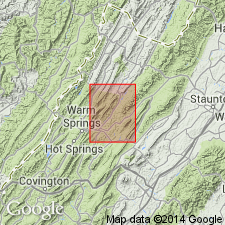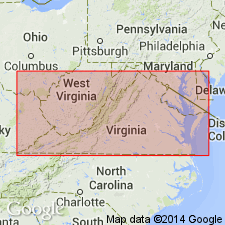
- Usage in publication:
-
- Big Valley formation
- Modifications:
-
- Named
- Dominant lithology:
-
- Limestone
- AAPG geologic province:
-
- Appalachian basin
Summary:
Named the Big Valley formation for Big Valley in western VA. Name is introduced to include the Ward Cove, Peery, and Benbolt formations of Kay (1956) where the Peery is not mappable and the Ward Cove and Benbolt are variable in lithology. Three type sections are designated in Big Valley, Hightown Valley, and Warm Springs Valley. Thickness of the Big Valley is 232 feet at the Big Valley section, 187 feet at the Hightown Valley section, and 204 feet at the Warm Springs section. Unit conformably overlies the Lincolnshire limestone and conformably underlies the McGlone formation. The lower contact is placed at the change from thick-bedded, coarse-grained, chert-bearing limestone to thin-bedded, fine-grained cherty limestone. Upper contact is placed at the base of the aphanitic limestone resembling the Five Oaks member of the Lurich formation. The Big Valley is of Middle Ordovician age.
Source: GNU records (USGS DDS-6; Reston GNULEX).

- Usage in publication:
-
- Big Valley Formation
- Modifications:
-
- Age modified
- AAPG geologic province:
-
- Appalachian basin
Summary:
The age of the Big Valley Formation is changed from Middle Ordovician to Late Ordovician. The Big Valley consists of medium- to coarse-grained, gray limestone with irregular argillaceous partings, dark gray, fine-grained, cobbly limestone, and dark gray argillaceous limestone with interbedded black shale similar to the Edinburg Formation. Unit includes limestones between the underlying Lincolnshire Limestone and overlying McGlone Formation. Thickness ranges from 190 to 230 feet. The depositional environment of the Big Valley Formation is interpreted to be subtidal ramp to slope/basin. The Big Valley Formation in Highland Co., VA correlates with the lower part of the Edinburg Formation in Botetourt Co.
Source: GNU records (USGS DDS-6; Reston GNULEX).
For more information, please contact Nancy Stamm, Geologic Names Committee Secretary.
Asterisk (*) indicates published by U.S. Geological Survey authors.
"No current usage" (†) implies that a name has been abandoned or has fallen into disuse. Former usage and, if known, replacement name given in parentheses ( ).
Slash (/) indicates name conflicts with nomenclatural guidelines (CSN, 1933; ACSN, 1961, 1970; NACSN, 1983, 2005, 2021). May be explained within brackets ([ ]).

